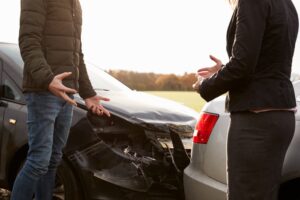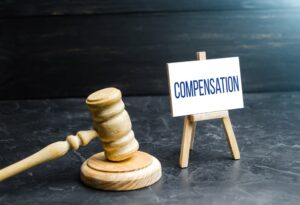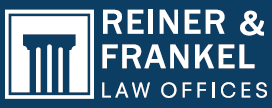Getting hit from the side in a T-bone crash can turn your world upside down in seconds. These accidents happen when one car slams into another car’s side, creating a T-shape at impact.
The damage is often severe, and the injuries can be life-changing. When dealing with medical bills, car repairs, and lost income, figuring out who caused the crash becomes vital for getting the money you need to recover.
T-bone accidents rarely happen by chance. Someone made a mistake, broke a traffic rule, or acted carelessly behind the wheel. Finding out exactly what went wrong requires careful investigation and legal knowledge that most people don’t have. That’s why getting help from a car accident attorney is vital after this type of crash.

Understanding T-Bone Collisions
T-bone accidents get their name from how they look after impact. One vehicle’s front end crashes into another vehicle’s side, forming a T-shape. These crashes are also called side-impact collisions or broadside accidents. They commonly happen at intersections, parking lots, and anywhere cars cross paths at right angles.
The physics of these crashes makes them particularly dangerous. When a car gets hit from the side, the impact zone has less protection than the front or back of the vehicle.
Door frames and side panels provide some safety but can’t absorb impacts like the engine compartment or trunk area. It means people inside the struck vehicle often face serious injuries, especially those sitting on the sides that get hit.
Speed plays a huge role in how bad the damage becomes. A T-bone crash at 30 miles per hour causes much different injuries than one at 55 miles per hour. Higher speeds mean more force, which leads to worse vehicle damage and more severe injuries for everyone involved.
Common Causes of T-Bone Accidents
Most T-bone crashes happen because someone failed to follow basic traffic rules. Running red lights tops the list of causes. When a driver speeds through an intersection after the light turns red, they often crash into cars that started moving when their light turned green. These accidents happen fast, giving neither driver much time to react.
Failing to stop at stop signs creates similar problems. Some drivers roll through stop signs without coming to a complete stop, and others don’t see the sign at all. When they enter an intersection without stopping, they crash into cars that have the right of way.
Left turns cause many T-bone accidents, too. Making a left turn across traffic requires careful timing and good judgment. Drivers who misjudge oncoming traffic speeds or try to beat yellow lights often get T-boned by cars going straight through the intersection.
Distracted driving makes all these situations worse. Drivers who are texting, talking on phones, or dealing with other distractions miss traffic signals and signs. They don’t see other cars until it’s too late to stop or change direction.
Weather conditions can contribute to T-bone crashes but rarely excuse poor driving decisions. Rain, snow, or fog might make it harder to see traffic signals, but drivers are expected to adjust their behavior accordingly. Going too fast for conditions or failing to leave enough stopping distance can lead to liability, even when weather plays a role.
Determining Fault in T-Bone Crashes
Figuring out who caused a T-bone accident requires looking at several pieces of evidence. Traffic laws provide the starting point. The driver who violated traffic rules usually bears responsibility for the crash. It might seem straightforward, but insurance companies often try to shift blame or claim both drivers share responsibility.
Police reports contain important information about what happened. Officers who respond to accident scenes interview witnesses, examine vehicle damage and note traffic signal positions. They also look for signs of speeding, alcohol use, or other factors that might have contributed to the crash. However, police reports don’t always tell the complete story and can contain mistakes.
Traffic camera footage can provide clear evidence of what happened before and during the crash. These cameras often capture traffic light changes, vehicle positions, and driver behavior. Not all intersections have cameras, but when they exist, this footage can be extremely valuable for proving fault.
Witness statements add another layer of evidence. People who saw the accident can describe what they observed about traffic signals, vehicle speeds, and driver actions. Their accounts help create a complete picture of the events leading up to the crash.
Vehicle damage patterns also tell a story about how the accident happened. The location and severity of damage on both cars can show which direction each vehicle was traveling and how fast they were going. Accident reconstruction experts can use this information to create detailed analyses of what occurred. Right-of-Way Rules and T-Bone Accidents
Right-of-Way Rules and T-Bone Accidents
Understanding right-of-way rules is essential for determining fault in T-bone crashes. These rules establish which driver should proceed first in different traffic situations. The driver who violates right-of-way rules typically gets blamed for the resulting accident.
At intersections with traffic lights, the rules seem clear. Drivers with green lights have the right of way over those facing red lights. However, complications arise when lights are changing or when drivers claim they had a green light. Traffic light timing records can help resolve these disputes, but getting access to this information often requires legal help.
Stop sign intersections follow different rules. The first car to reach the intersection usually has the right of way. When multiple cars arrive at the same time, specific rules determine who goes first. These situations can become complicated when drivers disagree about who arrived first or whether someone actually stopped.
Four-way stops create their own challenges. Drivers must come to complete stops and yield to cars that arrived before them. When accidents happen at four-way stops, determining the order of arrival becomes necessary for assigning fault.
Left turns almost always yield to oncoming traffic. Drivers making left turns must wait for a safe gap in traffic before proceeding. If they misjudge the situation and get hit by an oncoming car, they usually bear responsibility for the crash. However, situations involving yellow lights or sudden speed changes by oncoming traffic can complicate these cases.
Special Situations in T-Bone Accidents
Some T-bone accidents involve unique circumstances that make fault determination more complex. Parking lot crashes often happen without clear traffic signals or signs. Drivers must rely on general right-of-way principles and common sense. The layout of parking lot lanes and the direction each car was traveling become vital factors in these cases.
Emergency vehicle accidents create special legal considerations. Cars must yield to ambulances, fire trucks, and police cars with active lights and sirens. However, emergency vehicles must also operate safely and follow certain procedures. If an emergency vehicle causes a T-bone crash while responding to a call, fault determination requires careful analysis of whether proper protocols were followed.
Construction zones change normal traffic patterns and can lead to confusing situations. Temporary signs, flaggers, and altered lane markings create new rules drivers must follow. When T-bone accidents happen in construction zones, investigators must determine whether proper signage was in place and whether drivers followed the temporary traffic control measures.
Mechanical failures can also complicate fault determination. If a car’s brakes fail or its steering stops working, the driver might not be at fault for the resulting accident. However, proving mechanical failure requires experts’ analysis and documentation. Drivers are also responsible for maintaining their vehicles in safe working conditions.
Insurance Company Tactics
Insurance companies have teams of adjusters and lawyers whose job is to minimize payouts after accidents. They use several tactics to reduce their financial responsibility, especially in T-bone accidents where injuries tend to be severe and expensive.
One common tactic involves disputing the traffic light sequence. Insurance adjusters might claim their driver had a green light, even when evidence suggests otherwise. They may question witness reliability or argue that traffic signal timing created an ambiguous situation.
Another approach involves claiming both drivers share fault for the accident. Even when their driver clearly violated traffic rules, insurance companies might argue that the other driver could have avoided the crash by being more careful or driving slower. This tactic aims to reduce their payout by spreading responsibility between both parties.
Insurance adjusters also try to minimize injury claims by questioning medical treatment or suggesting that injuries weren’t caused by the accident. They might argue that pre-existing conditions are responsible for current symptoms or that the injured person waited too long to seek medical care.
Quick settlement offers represent another common tactic. Insurance companies often contact accident victims within days of the crash, offering fast settlements that seem generous but actually fall far short of covering all damages. These offers usually expire quickly, pressuring victims to accept inadequate compensation before they fully understand their injuries and losses.
The Importance of Legal Representation
Dealing with T-bone accident claims without legal help puts you at a serious disadvantage. Car accident lawyers understand the tactics insurance companies use and know how to counter them effectively. They have experience investigating these crashes and know what evidence to look for.
Your attorney will start by conducting a thorough investigation of the accident. It includes reviewing police reports, interviewing witnesses, and examining all available physical evidence. They may hire accident reconstruction experts to analyze vehicle damage and create detailed reports about how the crash happened.
Legal representation becomes especially important when injuries are severe. T-bone accidents often cause significant injuries that require long-term medical treatment. Calculating the full cost of these injuries requires understanding both current medical expenses and future care needs. Lawyers work with medical experts to document all injury-related costs and ensure nothing gets overlooked.
Lawyers also handle all communication with insurance companies. It protects you from saying something that can be used against your claim later. Insurance adjusters are trained to ask questions that might undermine your case, but lawyers know how to respond appropriately while protecting your interests.
Having experienced legal representation becomes even more critical if your case goes to court. Effectively presenting evidence, questioning witnesses, and arguing legal points requires knowledge and courtroom experience that most people lack.
Building Your Case
Creating a strong T-bone accident case requires gathering multiple types of evidence and presenting them in a way that clearly shows what happened and who was at fault. Your car accident attorney will develop a comprehensive strategy for building the strongest case.
Medical documentation forms the foundation of any injury claim. It includes emergency room records, diagnostic tests, treatment notes, and rehabilitation reports. Your lawyer will work with your doctors to ensure all injuries are properly documented and linked to the accident.
Property damage evidence shows the force of impact and can support injury claims. Photos of both vehicles, repair estimates, and total loss valuations all contribute to understanding the severity of the crash. Sometimes, the extent of vehicle damage alone can demonstrate that serious injuries were likely.
Economic losses must be carefully calculated and documented. It includes medical bills, lost income, and reduced earning capacity. Your lawyer will gather employment records, tax returns, and other financial documents to show exactly how the accident has affected your income.
Expert testimony can strengthen your case significantly. Accident reconstruction specialists can explain exactly how the crash happened and who was at fault. Medical experts can testify about your injuries and future treatment needs. Economic experts can calculate lifetime losses for permanent disabilities.
Moving Forward After a T-Bone Accident
T-bone accidents can be life-changing, but you don’t have to face the aftermath alone. Understanding fault is just the first step in getting compensation. The legal process can be overwhelming, especially with injuries and financial stress.
Every T-bone accident case is unique, and insurance companies will try to minimize payouts. Experienced legal representation can help ensure fair treatment. Contact a car accident lawyer as soon as possible to build a strong case, as evidence disappears quickly, and witnesses forget details.
Let a qualified attorney handle the legal complexities while you focus on recovering. Consultations are typically free, and you won’t pay fees unless your case is successful. Experienced legal guidance can help you understand your options and protect your rights. Contact us today!
